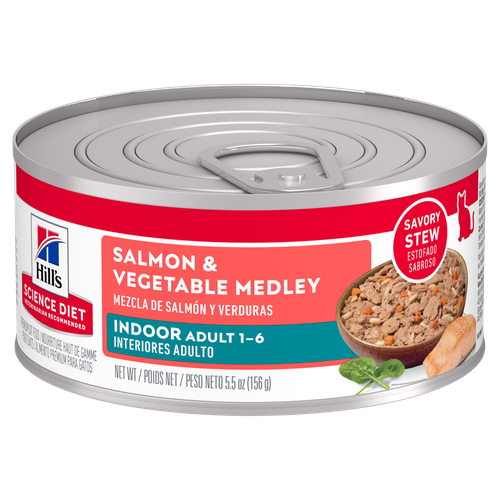
-
Find the right food for your petTake this quiz to see which food may be the best for your furry friend.Find the right food for your petTake this quiz to see which food may be the best for your furry friend.Featured products
 Adult Large Breed Chicken & Barley Recipe Dog Food
Adult Large Breed Chicken & Barley Recipe Dog FoodSupports healthy joints, lean muscle, and beautiful coat for large breed dogs
Shop Now Adult Chicken & Barley Recipe Dog Food
Adult Chicken & Barley Recipe Dog FoodSupports lean muscle and beautiful coat for adult dogs
Shop Now Hill's Science Diet Adult Chicken & Beef Entrée Dog Food
Hill's Science Diet Adult Chicken & Beef Entrée Dog FoodChicken & Beef Entrée in a delicious loaf with complete & balanced nutrition to help keep adult dogs active and healthy
Shop NowFeatured products Adult Indoor Salmon & Vegetable Medley Cat Food
Adult Indoor Salmon & Vegetable Medley Cat FoodPrecisely balanced nutrition for indoor cats with the delicious taste of savory salmon and vegetables
Shop Now Adult 7+ Senior Vitality Chicken & Vegetable Stew Cat Food
Adult 7+ Senior Vitality Chicken & Vegetable Stew Cat FoodImproves Everyday Ability to Get Up & Go
Shop Now Adult Chicken Recipe Cat Food
Adult Chicken Recipe Cat FoodSupports lean muscle and beautiful fur for adult cats
Shop Now -
Dog
- Dog Tips & Articles
-
Health Category
- Weight
- Food & Environmental Sensitivities
- Urinary
- Digestive
- Joint
- Kidney
-
Life Stage
- Puppy Nutrition
- Adult Nutrition
- Senior Nutrition
Cat- Cat Tips & Articles
-
Health Category
- Weight
- Skin & Food Sensitivities
- Urinary
- Digestive
- Kidney
-
Life Stage
- Kitten Nutrition
- Adult Nutrition
Featured articles What Is Littermate Syndrome? Pet Adoption Guide
What Is Littermate Syndrome? Pet Adoption GuideLearn more about littermate syndrome in dogs and cats and how to successfully navigate adoption and early socialization processes.
Read More How to Properly Mix Wet & Dry Pet Foods
How to Properly Mix Wet & Dry Pet FoodsAn Orange cat eating from a bowl filled with mixed food
Read More The Science Behind Our Love for Pets
The Science Behind Our Love for PetsLearn the scientific reasons why we have such strong connections with our pets, and what science says about the love between humans and our furry friends.
Read More -


Have you ever noticed that extra nail on the side of your dog's paw? It might look like a sort of "dog thumb." That's called a dewclaw, and it's a remnant of the evolutionary past of your family pet.
Why Do Dogs Have Dewclaws?

Psychology Today author Dr. Stanley Coren traces your dog's dewclaw back 40 million years to "a tree climbing cat-like animal known as miacis which was an early ancestor of our modern dogs," he says.
"Obviously if you climb trees having five toes is an advantage. However, miacis eventually evolved into the ground dwelling species cynodictus. From this point on, successive generations of the animals that would become our dogs began to become specialized as social hunters," Dr. Coren writes.
That means the extra nail serves little purpose for today's pups. Despite that, most dog breeds still have them on their front paws. Some breeds, like the Great Pyrenees and Briards, have rear dewclaws or can have double dewclaws — called polydactyly.
While they are considered to be of little use, they are certainly not completely useless. Dogs can use them for grip. Most commonly you might see your pup gripping a bone with the help of his "thumb." A dog breed that uses his "thumbs" is a Norwegian lundehund that uses them to help him scale mountains, according to the American Kennel Club (AKC).


Tasty Tips
The Dewclaw Debate
The AKC, however, notes that, for most dogs, the appendage is "essentially an extra paw" and "serves virtually no purpose" for most dogs.
Because of that and because some dogs are prone to getting them caught or torn — which can cause a dog extreme pain and risk infection — the AKC calls dewclaw removal one of the "safe and standard animal husbandry practices designed to protect the safety and welfare of dogs."
The AKC calls for the appendages to be removed shortly after birth. In fact, many dog breeders have the surgery done in his first days of life. That means if your dog doesn't have dewclaws, they might have been removed before you even took ownership of your pup.
But other organizations strongly believe that removing dewclaws serves little purpose and causes great pain to the animal. Because of that, some — like The Kennel Club in the UK — have restrictions on when dewclaw removal can be done.
"Beyond the risk of the dewclaw getting caught on things, there is no benefit to removing them," Albuquerque Vetco says. "It can also be a painful procedure for your dog."
Vets at the New Mexico clinic recommend owners keep the nail of the appendage trimmed short to help prevent it from catching and potentially tearing. Whatever you decide to do with your dog's dewclaw, you should consider keeping all of his claws trimmed. Unlike his ancestors or canine cousins in the wild, dog claws don't serve as great of an evolutionary need as they aren't necessary for hunting prey. After all, your lovable pup would much rather you feed him a nutritious meal than have to go hunt for his own.
The debate continues, but your dog certainly doesn't know that. All he cares about — whether he has his extra claw or not — is that he surely has full grasp on your heart.


Kara Murphy is a freelance writer and pet parent who lives in Erie, Pa. She has a goldendoodle named Maddie.
Related products

Chicken & Barley Entrée in a delicious loaf with great taste and precisely balanced nutrition to support 5 essential building blocks for lifelong health

Supports healthy joints, lean muscle, and beautiful coat for large breed dogs

Chicken & Beef Entrée in a delicious loaf with complete & balanced nutrition to help keep adult dogs active and healthy

Supports lean muscle and beautiful coat for adult dogs
Related articles

Wondering where can I buy a dog? Consider adoption and explore the pros and cons of adopting a dog from a breeder versus an animal shelter.

Discover how the field of dog science is giving us more and more insights into the inner workings of our furry best friends.

Your dog's coat and skin are a big part of your dog's overall health. Ensure you keep your dog's coat healthy, by following these simple tips.

Learn how to help keep your dog's immune system in tip-top shape, including nutritional immune system support for dogs and other strategies.

Put your dog on a diet without them knowing
Our low calorie formula helps you control your dog's weight. It's packed with high-quality protein for building lean muscles, and made with purposeful ingredients for a flavorful, nutritious meal. Clinically proven antioxidants, Vitamin C+E, help promote a healthy immune system.
Put your dog on a diet without them knowing
Our low calorie formula helps you control your dog's weight. It's packed with high-quality protein for building lean muscles, and made with purposeful ingredients for a flavorful, nutritious meal. Clinically proven antioxidants, Vitamin C+E, help promote a healthy immune system.

